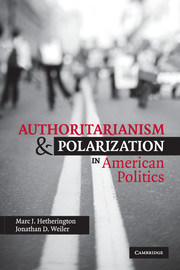Book contents
- Frontmatter
- Contents
- Acknowledgments
- 1 Spanking or Time Out: A Clash of Worldviews?
- 2 Putting Polarization in Perspective
- 3 Authoritarianism and Nonauthoritarianism: Concepts and Measures
- 4 A Historical Account of the Roots of Worldview Evolution
- 5 Authoritarianism's Structuring of Contemporary Issues
- 6 Threat and Authoritarianism: Polarization or Convergence
- 7 Evidence of Worldview Evolution
- 8 Immigration: A Reinforcing Cleavage that Now Constrains the Republican Party (GOP)
- 9 What the 2008 Democratic Nomination Struggle Reveals about Party Polarization
- 10 A New View of Polarization
- Epilogue
- Bibliography
- Index
8 - Immigration: A Reinforcing Cleavage that Now Constrains the Republican Party (GOP)
Published online by Cambridge University Press: 05 June 2012
- Frontmatter
- Contents
- Acknowledgments
- 1 Spanking or Time Out: A Clash of Worldviews?
- 2 Putting Polarization in Perspective
- 3 Authoritarianism and Nonauthoritarianism: Concepts and Measures
- 4 A Historical Account of the Roots of Worldview Evolution
- 5 Authoritarianism's Structuring of Contemporary Issues
- 6 Threat and Authoritarianism: Polarization or Convergence
- 7 Evidence of Worldview Evolution
- 8 Immigration: A Reinforcing Cleavage that Now Constrains the Republican Party (GOP)
- 9 What the 2008 Democratic Nomination Struggle Reveals about Party Polarization
- 10 A New View of Polarization
- Epilogue
- Bibliography
- Index
Summary
In the early twenty-first century, immigration reform, as has periodically been the case, clawed its way onto the national issue agenda. One explanation for its reemergence is simple reality. An estimated forty-seven million foreign-born individuals now reside in the United States, and while no precise figures are possible, it is typically estimated that roughly a quarter are in the country illegally. Significantly, illegal immigration has increased dramatically since the early 1990s, with an estimated ten million illegal immigrants arriving between 1990 and 2005 (Pew Hispanic Center 2005). In fact, the undocumented represent the fastest growing portion of the immigrant population.
There are political realities also at play. Over half of all immigrants come from Mexico, and, combined with immigrants from elsewhere in Latin America, Hispanics now comprise a majority of the foreign-born population in the United States (Pew Hispanic Center 2008). Even though many of these immigrants are in the country illegally, children born to them are, by law, U.S. citizens. This makes both legal and illegal immigrants politically relevant. As of 2007, Latino Americans had surpassed African Americans as the largest racial or ethnic minority in America. Therefore, politicians stand to reap a harvest of new voters if they can appeal successfully to this group (Judis and Teixeira 2002). At the same time, however, such gains might come at the cost of existing supporters, something the Democrats experienced when whites fled the party with the enactment of the Voting Rights Act of 1965, as we discussed in Chapter 4.
- Type
- Chapter
- Information
- Authoritarianism and Polarization in American Politics , pp. 160 - 173Publisher: Cambridge University PressPrint publication year: 2009



